- Understanding Developmental Delays
- Recognizing Toilet Training Readiness
- Addressing Physical Challenges
- Toilet Training With Sensory Disabilities
- Approaches for Different Conditions
- Preparation for Toilet Training
- Effective Training Techniques
- The Role of Support in Training
- Embracing Training Milestones
- Dealing With Accidents
- Initiating Toilet Training
- Tackling Sensory Issues
- Navigating Challenges in Neurodivergent Children
- Exploring Additional Support Options
- Frequently Asked Questions
- How Do You Potty Train a Child With a Developmental Delay?
- How to Potty Train a Child With Sensory Processing Disorder?
- What Procedure Is Vital When Toilet Training Children With Intellectual and Developmental Disabilities?
- Is It Normal for a 4-Year-Old to Not Be Potty Trained?
- Are these toilet training tips helpful for children without developmental delays?
- Conclusion
Key Takeaways
- Personalized toilet training approaches can assist children with developmental delays, including sensory modulation and DIR/Floortime therapies.
- Caregivers should observe for readiness cues and adapt training methods to suit children’s unique needs and challenges.
- Addressing physical obstacles and sensory issues is crucial, with strategies such as using soft toilet paper or introducing soothing scents.
- Reward systems and positive reinforcement can motivate progress in toilet training, fostering a sense of achievement and independence.
- Support from caregivers, educators, and professionals like pediatricians or therapists is essential, providing guidance, motivation, and tailored strategies.
Understanding Developmental Delays
In child development, it’s essential to understand that developmental delays can significantly impact a child’s ability to reach toilet training milestones at the typical age. Incorporating Pediatric Therapy early can be beneficial as it utilizes task analysis, modeling, and positive reinforcement to promote self-care skills such as toileting.
Children with developmental delays often face specific challenges in toilet training, particularly regarding communication and body awareness. These struggles can understandably cause anxiety and frustration for both the child and their caregivers. A personalized approach involving sensory modulation and DIR/Floortime therapies can help meet these individual needs.
Thus, personalized approaches are necessary when toilet training children with developmental delays. Recognizing and accommodating a child’s needs can lead to more successful outcomes. For example, a child with a communication delay might benefit from using picture cards or signing to express their toileting needs. In contrast, a child with sensory processing issues might need a quieter, less stimulating bathroom environment.
Patience and consistency are essential when working with children with developmental delays. Toilet training is complex, and progress may be slower than in typically developing children. Understanding these specific challenges can help caregivers create an empathetic and supportive environment for children as they navigate the process of toilet training.
Recognizing Toilet Training Readiness
Recognizing toilet training readiness in children with developmental delays is a nuanced process that hinges on understanding the child’s distinct cues and behaviors. As part of the broader spectrum of ADL skills, it involves acknowledging their specific learning styles and communication abilities, which may differ from those of typically developing children. In the context of fine motor skills and sensory strategies, adaptability in training methods is paramount. Finding success in this phase requires patience, informed observation, and flexibility in training methods.
Identifying Readiness Signs
How can one discern the signs of readiness for toilet training in a child with developmental delays? Identifying readiness is an initial step in the process. It’s vital to remember that this is part of the child’s self-care journey, which promotes independence and well-being. Children with developmental delays may exhibit different signs, or these signs may present later than in typically developing children. However, common signs of readiness include staying dry for extended periods, showing interest in the bathroom, or communicating about bodily functions.
Observation and understanding the child’s specific behaviors and communication style are vital in identifying these readiness signs. Look for cues like pulling at a wet diaper, hiding during bowel movements, or imitating family members in the bathroom. Patience, empathy, and a deep understanding of the child’s unique needs are crucial.
Navigating Training Obstacles
While every child’s path toward toilet independence is unique, it can be particularly challenging for those with developmental delays. Recognizing toilet training readiness in children with developmental delays can present distinct obstacles. However, these challenges can be navigated successfully with patience, understanding, and a tailored approach.
Part of this tailored approach involves teaching daily self-care activities, which include toileting, grooming, dressing, eating, and mobility tasks. This can foster children’s independence, fine motor skills, and overall development.
It’s crucial to keep in mind that children with developmental delays may:
- Exhibit different signs of readiness for toilet training
- Experience challenges in recognizing and communicating their bathroom needs
- Require rewards and training methods tailored to their unique needs and readiness level
- Benefit significantly from professional consultation, such as occupational therapists, to overcome obstacles
Occupational therapists often recommend prioritizing self-care for children and can provide valuable guidance.
Addressing Physical Challenges
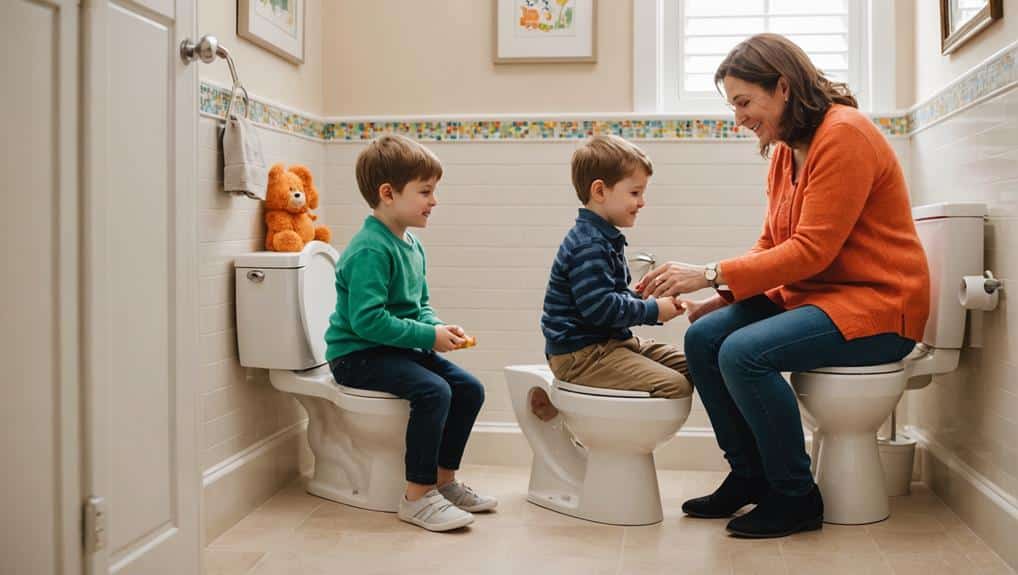
Exploring the path of toilet training can be a steep climb for children grappling with physical obstacles. The voyage may be challenging, especially for children with developmental delays or special requirements. Conditions like cerebral palsy or spina bifida can significantly affect toilet awareness and control, making traditional training methods ineffective.
These physical obstacles require customizing methods to suit these children’s distinct needs. By adjusting strategies to their physical limitations, we can assist them in gaining a sense of authority and self-reliance. For example, children with spinal cord injuries may need specialized techniques like catheterization. Methods such as sensory exploration and play therapy can help ease the toilet training process for such children.
It’s essential to seek advice from healthcare professionals to comprehend the best approaches for these specific circumstances. Caregivers play a crucial role, offering extra support, patience, and consistency during this process. Their unwavering dedication can cultivate a supportive environment conducive to learning and progress. Every child is unique; success can’t be measured in standard timelines. However, recognizing readiness indicators and celebrating milestones can be beneficial progress markers.
With customized strategies and supportive care, we can navigate the intricacies of toilet training for children facing physical obstacles, progressing toward a future of enhanced independence and confidence.
Toilet Training With Sensory Disabilities
Toilet training can pose unique challenges for the estimated one in six children who live with sensory disabilities. In many of these children, sensory processing disorder can complicate the process. This is where specific approaches come into play, catering to each child’s heightened sensitivities.
Understanding the specific challenges these children face is essential. Some may include:
- Sensory overload: Too much information can overwhelm these children, making it difficult for them to focus on the task at hand.
- Tactile sensitivity: For some, the feeling of toilet paper or the toilet seat itself can be uncomfortable or distressing.
- Difficulty with wiping techniques: Children with sensory disabilities often require explicit instructions and visual cues to master this vital skill.
- Sensitivity to sounds and smells: The flushing sound or certain smells can be off-putting for children with sensory processing disorders.
Addressing these sensory aspects is crucial to creating a comfortable toileting environment. By individualizing support, monitoring progress, and adapting strategies as needed, we can help these children successfully navigate the toilet training process.
Approaches for Different Conditions
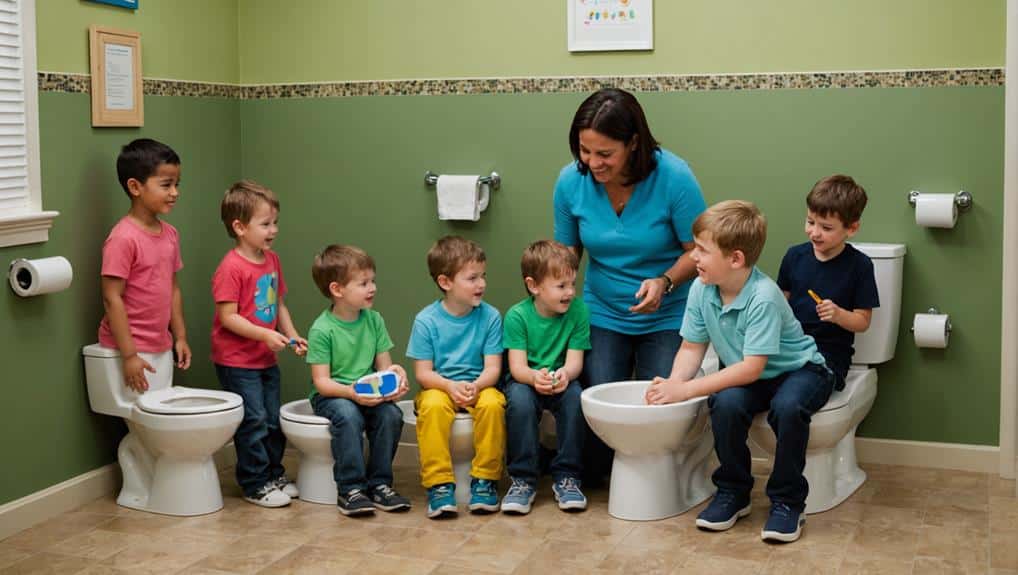
A significant proportion of children with developmental delays, such as cerebral palsy, spina bifida, spinal cord injuries, autism, ADHD, and intellectual disabilities, face specific challenges in toilet training. These special needs children must understand their issues and adopt customized training strategies.
Children with cerebral palsy often struggle with bladder control development, requiring patient, delayed training into later ages. Spina bifida and spinal cord injuries can impact toilet awareness, usually requiring the introduction of catheterization and bowel management strategies.
Children with autism spectrum disorder or ADHD, both classified as behavioral disorders, present distinctive challenges. These children may require careful, consistent training approaches that reduce stress and optimize routine and predictability.
Notably, children with intellectual disabilities may require even more personalized training strategies due to the wide range of abilities and challenges within this category. Focusing on one skill at a time can lead to gradual progress for these children.
In the end, understanding a child’s developmental disabilities allows us to create a toilet training approach that respects their pace and enhances their potential for success.
Preparation for Toilet Training
While preparing for toilet training, it is essential to remember that children with developmental delays may require unique strategies for success. Recognizing these children’s specific needs and customizing the environment for their comfort can significantly enhance the effectiveness of the training process.
Understanding your child’s distinct learning style and challenges is a vital aspect of preparation. Recognizing and accommodating these factors can create a supportive environment encouraging gradual progress.
To illustrate, here are four critical steps in preparation for toilet training:
- Identify and comprehend the child’s learning style and challenges.
- Customize the bathroom environment according to the child’s needs.
- Develop a reward system that aligns with the child’s interests and motivators.
- Observe and respond to readiness cues, indicating when the child is ready to proceed.
Effective Training Techniques
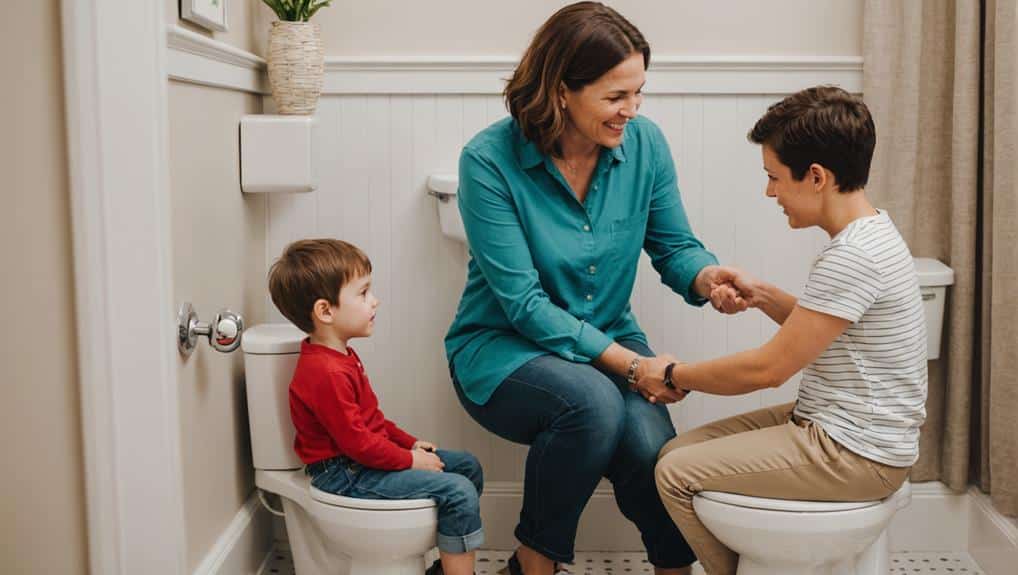
Implementing successful training techniques can often seem like a complex maze for parents of children with developmental delays. However, detailed toilet training programs rooted in applied behavior analysis principles have successfully trained children with autism and other special needs.
Azrin and Foxx’s esteemed book, “Toilet Training in Less than a Day,” provides clear procedures for typically developing children and those with developmental delays. Their approach highlights the importance of rewarding children throughout the process, a crucial element in motivating them to reach their developmental milestones.
One efficient method is breaking the process into manageable steps and rewarding the child for each achievement, such as simply entering the bathroom. This gradual approach can help children with developmental delays overcome the obstacles inherent in toilet training.
Furthermore, teaching children alternative communication methods, like sign language or visual aids, can help them express their need for the toilet. This enables children to convey their needs effectively, promoting confidence and independence. When applied patiently and consistently, these methods can significantly improve the toilet training journey for the child and their caregivers.
The Role of Support in Training
Support for children with developmental delays during toilet teaching cannot be exaggerated. This crucial process requires a collaborative effort from caregivers, therapists, and educators who offer much-needed guidance and motivation.
To effectively aid in the teaching process, these parties must grasp the distinct needs and obstacles children with developmental delays face. Their role goes beyond mere supervision; it involves being patient, consistent, and providing positive reinforcement.
- Caregivers provide familiarity and comfort, easing the teaching process.
- Therapists apply their expertise in developmental conditions to create suitable teaching methods.
- Educators can integrate toilet teaching into the child’s daily schedule at school, ensuring consistency.
- All must work together to facilitate a smoother, more effective adjustment for the child.
Resources are accessible to support these individuals in their roles. Professional guidance, educational materials, and support groups can significantly improve the teaching process, making it more effective and less stressful. Support in toilet teaching is crucial, and the right approach and resources can make a significant difference for children with developmental delays.
Embracing Training Milestones
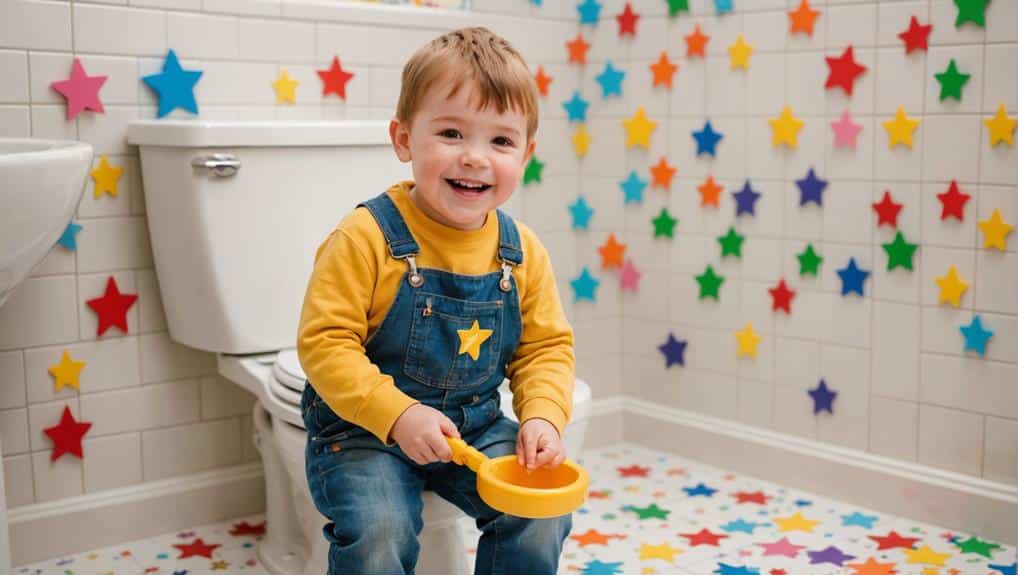
Exploring the path of toilet training with a child with developmental delays can present unique challenges, but it also offers opportunities for growth and celebration. Recognizing and embracing each milestone, no matter how small fosters a sense of achievement and strengthens the child’s confidence.
Children with developmental disabilities often reach toilet training milestones at their own pace, which may occur later than their typically developing peers. This difference does not cause worry but highlights each child’s journey. As parents, your patience, understanding, and support are invaluable. Celebrating these milestones, however small they may appear, not only encourages your child’s progress but also provides a much-needed morale lift for everyone involved.
There is no set age for toilet training readiness, especially for children with developmental delays. Therefore, parental support is vital in guiding the child through this process. Encouraging and reinforcing your child’s efforts in toilet training contributes significantly to their overall growth. Remember, each milestone reached is worth celebrating and a significant step towards greater independence.
Dealing With Accidents
Starting on the journey of toilet training with a child who has developmental delays can sometimes be marked by accidents, a common occurrence in this process.
Despite the challenges, it is essential to remain supportive and understanding. Accidents can stem from difficulty recognizing the need to use the toilet. Therefore, we are responsible for guiding the child, reducing theiety, and enhancing their confidence.
To successfully navigate through this phase, consider the following steps:
- Aim for consistent routines, as familiarity can help the child anticipate toilet times.
- Provide gentle, timely reminders, subtly guiding the child towards recognizing the need.
- Stay patient and supportive, reinforcing that accidents are part of learning.
- Celebrate small victories with positive reinforcement to encourage progress and build self-esteem.
Initiating Toilet Training
Having established strategies to deal with accidents, we can now focus on initiating toilet training for children with developmental delays. Commencing toilet training may require specific programs utilizing behavioral analysis principles. Proper procedures, such as those detailed in Azrin and Foxx’s literature, can facilitate training for children with developmental challenges.
A fundamental part of this process is the use of solid rewards. Employing incentives can motivate the child during toilet training and create positive connections with successful toileting experiences. This approach fosters an environment of encouragement and progress, easing the child’s shift into toilet use.
Furthermore, introducing communication methods such as sign language or visual aids can be advantageous. These tools enable children to express their need to use the toilet, enhancing their autonomy and communication skills.
Starting toilet training is about more than just teaching children to use the toilet; it’s about gradually building independence. Focusing on this development aspect can enhance the overall quality of life for children with developmental delays, making training a more fulfilling experience for all involved.
Tackling Sensory Issues
Addressing sensory issues is essential to toilet training for children with developmental delays. Sensory hypersensitivity can pose a significant challenge, and recognizing these sensory sensitivities is the initial step toward practical training.
Children with sensory challenges may have heightened responses to certain stimuli, making toilet training more challenging. To alleviate these sensory issues, consider the following strategies:
- Use soft toilet paper to minimize discomfort from the touch.
- Employ a low-volume flushing system or allow the child to leave the room before flushing to reduce noise sensitivity.
- Introduce soothing scents in the bathroom to counter hypersensitivity to smell.
- Demonstrate proper wiping techniques and provide consistent verbal cues to help the child understand the process.
Navigating Challenges in Neurodivergent Children
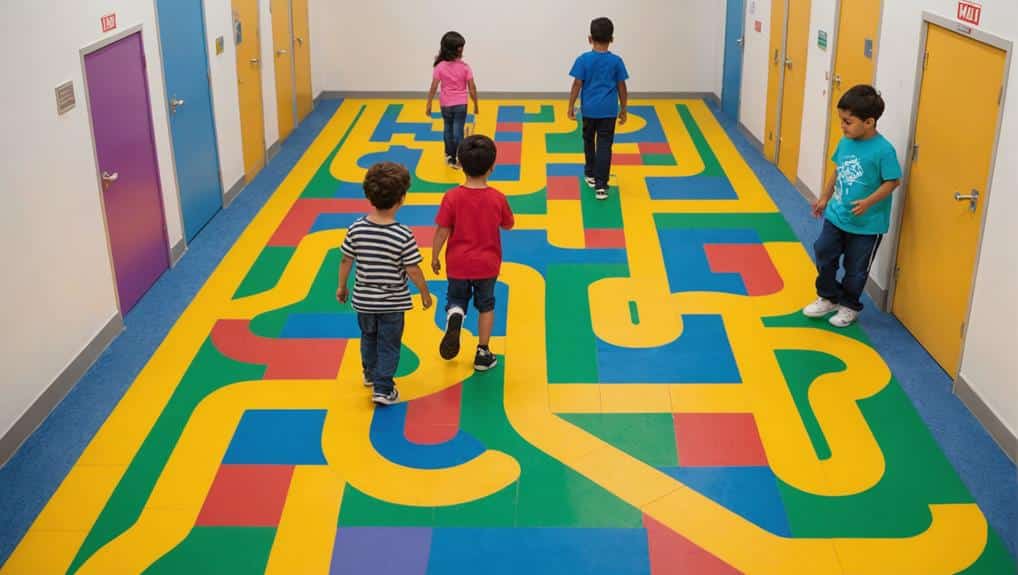
Neurodivergent children often encounter specific challenges in toilet training due to developmental delays. These challenges can manifest as continence issues, persisting into early adulthood in around 20% of these children. However, early toilet training can help mitigate these problems and guide a child towards independence.
Structured learning approaches, such as positive encouragement and behavioral training, can be highly effective in toilet training neurodivergent children. These methods provide a clear, predictable framework to ease the stress and confusion often associated with toilet training. Educators and caregivers must be patient, persistent, and empathetic, understanding that each child’s path toward independence may differ and require more time.
To illustrate, consider the table below:
| Approach | Advantage | Ideal for |
|---|---|---|
| Early start | Prevents ongoing issues | Children at higher risk |
| Positive encouragement | Motivates child | All children |
| Behavioral training | Provides clear framework | Neurodivergent children |
Exploring Additional Support Options
When starting toilet training, a child with developmental delays can often feel overwhelmed. However, keep in mind that you are not alone. There is a wealth of support options available to assist you.
Professionals, such as pediatricians and psychologists, are equipped with expert knowledge and can provide valuable guidance. They can help identify strategies tailored to your child’s specific needs.
Individual consultations offer tailored, one-on-one support to address specific challenges in toilet training. They can also provide practical strategies and techniques for applying at home.
Consider the following extra support options:
- Online resources: Websites, blogs, and videos provide information and practical tips.
- Support groups: Connecting with others in similar situations can offer emotional support and shared experiences.
- Therapists: Occupational and behavioral therapists can provide customized strategies for your child’s needs.
- Community support: Local organizations often offer resources and programs for families of children with developmental delays.
These resources can ease anxiety and strengthen you in your path. Remember, every child is different, and progress may not come quickly, but toilet training success is achievable with patience, understanding, and support.
Frequently Asked Questions
How Do You potty training a Child With a Developmental Delay?
Potty training a child with developmental delays requires a personalized approach, employing sensory strategies, visual supports, and reinforcement techniques. Maintaining a consistent routine while showing patience and encouragement dramatically aids in this learning process.
How to Potty Train a Child With Sensory Processing Disorder?
Implement sensory strategies and consistent routines during toilet training for a child with sensory processing disorder. Use visual schedules and positive reinforcement. Parental support and guidance from occupational therapy are critical to a successful shift.
What Procedure Is Vital When Toilet Training Children With Intellectual and Developmental Disabilities?
An essential procedure involves establishing a consistent routine with visual cues, using positive reinforcement, and implementing personalized communication strategies. Patience, persistence, and an empathetic approach greatly aid the process for children with developmental disabilities.
Is It Normal for a 4-Year-Old to Not Be Potty Trained?
Yes, it’s normal for a 4-year-old, particularly a late bloomer with developmental delays, not to be potty trained. Parental support, medical advice, addressing behavioral challenges, a personalized approach, and patience are essential in this process.
Are these toilet training tips helpful for children without developmental delays?
Yes, these toilet training tips can be helpful for all children. Patience, routine, and positive reinforcement work well for kids of all abilities.
Conclusion
To summarize, toilet training children with developmental delays requires a comprehensive, personalized approach. The achievement of this milestone depends on grasping the child’s distinct requirements, implementing appropriate methods, and offering sufficient assistance. Overcoming physical and sensory obstacles, comprehending neurodiversity, and exploring extra support options are crucial aspects of this process. Attaining success in toilet training dramatically enhances the child’s autonomy, self-esteem, and overall well-being.

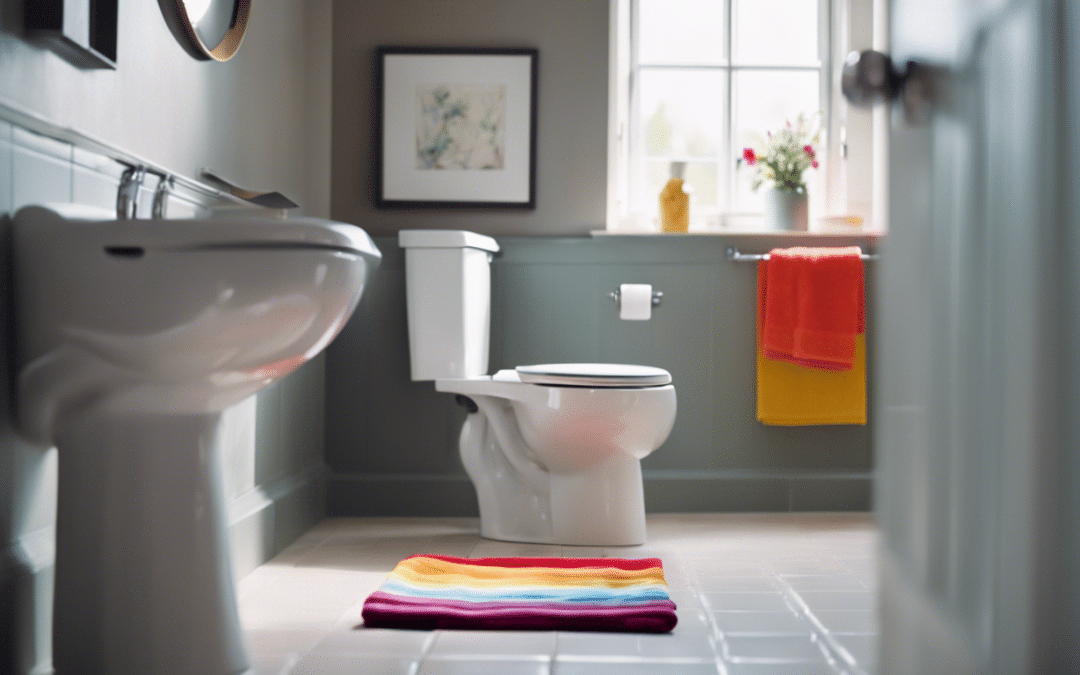
Recent Comments